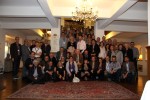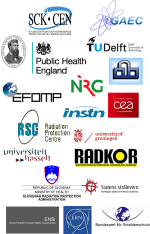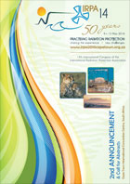EUTERP newsletter issue 10 - December 2015
President's message
 As we come to the close of 2015 I am, as always, surprised by how quickly the year has flown past. It only seems a few weeks ago that the EUTERP Board were drawing up the programme for the Athens Workshop, revising the Foundation Articles and planning EUTERP participation in a wide range of events and projects.
As we come to the close of 2015 I am, as always, surprised by how quickly the year has flown past. It only seems a few weeks ago that the EUTERP Board were drawing up the programme for the Athens Workshop, revising the Foundation Articles and planning EUTERP participation in a wide range of events and projects.The year is now ending and we have completed these tasks – some of which are reported on in this Newsletter - and are looking forward to further developing our activities in 2016. We will continue to promote education and training activities in radiation protection through our website, Newsletters and interactions with stakeholders. We can only carry out our work programme with your assistance, so many thanks to all our Associates and other partners for your continuing support.
Best wishes for the festive season and a happy and prosperous New Year to you all!
Richard Paynter President,
The EUTERP Foundation
The 6th EUTERP workshop “Legislative change in Europe: the implications for training in radiation protection - Rising to the challenge”, 30 September to 2 October 2015, held at the Hotel Stratos Vassilikos , Athens.
 This workshop focused on the required changes in legislation in the European Union and the associated training implications, as a result of the new Basic Safety Standards (BSS) Directive (2013/59/Euratom). Member States are required to bring into force the laws, regulations and administrative provisions necessary to comply with the new BSS Directive by February 6, 2018. This will be a challenge, requiring changes to national legislation, major revision of training activities and new approaches to the qualification and recognition of Radiation Protection Experts and Medical Physics Experts.
This workshop focused on the required changes in legislation in the European Union and the associated training implications, as a result of the new Basic Safety Standards (BSS) Directive (2013/59/Euratom). Member States are required to bring into force the laws, regulations and administrative provisions necessary to comply with the new BSS Directive by February 6, 2018. This will be a challenge, requiring changes to national legislation, major revision of training activities and new approaches to the qualification and recognition of Radiation Protection Experts and Medical Physics Experts. - Professionals who need rp information to carry out their work: eg solicitors, engineers – information provision.
- Exposed persons and workers – trying to achieve changes in behaviour.
- Members of the public - provision of information to enable informed judgements.
Progress of ENETRAP III progress
 The EC supported project ENETRAP III has now been running for 18 months. The first reporting period is therefore covered.
The EC supported project ENETRAP III has now been running for 18 months. The first reporting period is therefore covered.
In this period we have finalized the writing of the guidance for the implementation of E&T for RPE and RPO, taking into account the new BSS (Council Directive 2013/59/Euratom). This work was achieved in close collaboration with the HERCA Task Force on E&T and with the EUTERP Associates. The aim is to publish this document in 2016.
We have also developed three additional training modules for RPE working in nuclear power plants, the medical sector and geological disposal. In addition, a train-the-trainer module was developed.They will all run in 2016. More information including registration details is available on the ENETRAP III website.
In 2016 ENETRAP III will organise its mid-project dissemination workshop. This will be organised during the Radiation Protection Week in Oxford, 19-23 September 2016.
A follow-up on this project is reported via http://enetrap3.sckcen.be.
EUTERP website upgrade
 In the framework of the ENETRAP III project, it is proposed to use the EUTERP website as the main source of information for education and training in radiation protection in Europe. In order to optimize and extend the information already provided on the EUTERP website, some changes are currently deployed which alter the appearance and functionality of some webpages. Visit our website and watch us grow bigger, better and at your service!
In the framework of the ENETRAP III project, it is proposed to use the EUTERP website as the main source of information for education and training in radiation protection in Europe. In order to optimize and extend the information already provided on the EUTERP website, some changes are currently deployed which alter the appearance and functionality of some webpages. Visit our website and watch us grow bigger, better and at your service!
XII Italian Radiation Protection Forum
November 15-19, 2015, Ortisei (IT)
 The XII ANPEQ Italian Forum on radiation protection has just ended. It was held from 15 to 19 of November in the wonderful setting of the Dolomite mountains (UNESCO heritage).
The XII ANPEQ Italian Forum on radiation protection has just ended. It was held from 15 to 19 of November in the wonderful setting of the Dolomite mountains (UNESCO heritage).
The Forum was born on the initiative of Giorgio Cucchi (present NCP for Italy of E.U. EUTERP Foundation together with Elena Fantuzzi of ENEA) with the intent to provide radiation protection professionals (Radiation Protection Experts or Qualified Experts) with a venue where they can meet the representatives of the Italian Authorities (Government Departments and Supervisory Committees) to compare the mutual issues.
 The first Forum was in 1994 and up to this one there have been 11 Forums (with a two–yearly frequency) with Giorgio Cucchi as Chairman, Ehrenfried Moroder as secretary (kind and excellent host) and Marcus Haller as brilliant organizer.
The first Forum was in 1994 and up to this one there have been 11 Forums (with a two–yearly frequency) with Giorgio Cucchi as Chairman, Ehrenfried Moroder as secretary (kind and excellent host) and Marcus Haller as brilliant organizer.
The present XII Forum has taken up the usual update but also and particularly the new radiation protection directive 2013/59 Euratom of December the 5/ 2013 because also in Italy the law is now changing regarding this directive.
During the Forum the report of Giorgio Cucchi about the RPE figures (Radiation Protection Expert or Adviser in EU and Radiation Safety Officer in USA and Canada) as they are now in the world has pointed out that in most Countries the RPEs are designated according to the potential hazard of the sources used (for examples RPE level I, RPE level II, RPE level III) not according to the different applications. The medical and industrial applications are usually considered the same for the RPE figure while the role of the RPO (Radiation Protection Officer) is focused on more day-to-day supervision and control of work with radiation at a more hands-on level according to the specific application.
During the meeting also representatives of the Labour Ministry (A.G.Ahmad e Miglietta), Industry Ministry (U. Bollettini), Health Ministry (P.Rossi), INAIL (F. Campanella), Bologna University (D.Mostacci e M. Sumini) and ANPEQ (L.Biazzi, F.Bonacci, S.Cazzoli, P.B. Finazzi, L.Frittelli, D.Nucci e A.Sarandrea) have spoken.
S. Cazzoli
ANPEQ Honorary President
EUTERP Foundation Articles of Association
 During the EUTERP Associates’ meeting in Athens, held in October 2015, the Chairman Richard Paynter explained the changes proposed by the Board to the Articles of the EUTERP Foundation. The changes are:
During the EUTERP Associates’ meeting in Athens, held in October 2015, the Chairman Richard Paynter explained the changes proposed by the Board to the Articles of the EUTERP Foundation. The changes are:
- to delete the previous definition of “Expert”, acknowledging that there is an accepted definition of Radiation Protection Expert in the EURATOM Directive;
- to expand the role of EUTERP to facilitate the mobility of the radiation workforce between EUTERP countries;
- to facilitate the evaluation of assessment schemes;
- to clarify how the Directors are nominated by and voted for by the eligible Associates;
- to clarify that Directors (a new maximum of 8) are appointed for 3 years and may be re-appointed by vote of the Associates;
- to clarify that the Directors are actively involved in radiation protection;
- to clarify what constitutes an “eligible” Associate for “benefit” purposes;
These changes have now been approved by the EUTERP Notary and the amended Articles are being sent to the Associates for their comments. The Articles will be adopted by the Board on 1 January 2016 subject to the Articles being acceptable to the Associates. The formal process of elections to the next Board, following the requirements in the Articles will then begin.
EUTERP Associates
The EUTERP currently has 18 Associates, two are from European organisations and the others are from 12 European countries, with one further application pending. During the 6th EUTERP Workshop held in Athens, the first meeting of the Associates was held on the evening of 1 October. Various topics were presented and discussed, including the amended Articles of Association for the EUTERP Foundation, as mentioned in this Newsletter. One recommendation from the meeting was to invite other organisations involved in radiation protection education and training to become Associates.
The benefits, listed on the EUTERP website, are becoming more widely recognised and some Associates had clear ideas about whom would benefit and could be invited. Please would you let us know of any such organisations, in your country or elsewhere in Europe, with a contact name and e-mail address so that we can then invite them to join us. Any such organisation may of course apply directly, using the application form from the How to Join page on the EUTERP website.
We look forward to hearing from you!
EUTERP web usage
Upcoming events
 14 to 16 March 2016 , Bern, Switzerland
14 to 16 March 2016 , Bern, Switzerland
EAN 16th Workshop 2016
Industrial radiography and Non-destructive testing
 9 to 13 May 2016, Capetown, South Africa
9 to 13 May 2016, Capetown, South Africa
IRPA 14: celebrating 50 years IRPA
Practising Radiation Protection, sharing the experience and new challenges
2nd announcement E-brochure available online.